Local News
Simkin Centre dedicates memorial to the 11 residents who lost their lives to Covid last year – and unveils 5 new Chanukah menorahs
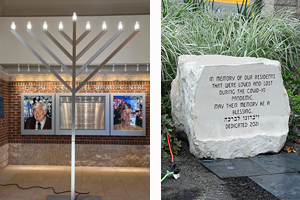
By BERNIE BELLAN It was a little more than one year ago that the Simkin Centre was hit hard by Covid for an almost two-month period. As I noted in a daily blog that I kept updating on this website, it was on December 14 that I was finally able to report that “as of today, there are no active cases of COVID-19 at the Simkin Centre. After almost two consecutive months with at least one active case every day – either among residents or staff, there is now reason to believe that the worst is over.”
But, what happened from October 22 – December 14 was nightmarish in scope.
A total of 40 cases were reported among both staff and residents, with 21 staff hit by Covid, while 29 residents also fell ill. While no staff died as a result of Covid, 11 residents did, beginning with Gwen Nelko on October 22 and ending with Mahmonir Vahdat on December 14.
On October 27 the Simkin Centre front entrance was the scene of a dedication of a memorial to the 11 residents who lost their lives to Covid during that terrible two-month period.
Rabbi Kliel Rose of Etz Chayim Congregation delivered remarks to members of families of the deceased who had gathered that cold October day, along with several employees who were also in attendance.
Marilyn Regiec read out the names of the 11 residents who died:
Gwen Nelko
Esther Shuster
Mary D Turner
Lena Parisien
Sheila Streifler
Luba Zalkind
Irene Fonseth
Annette Rosenberg
Gary Marantz
Hilda Loeppky
Mahmonir Vahdat
The memorial was donated by Larsen’s Memorials at no cost.
Project Menorah
Submitted by the Simkin Centre: During the darkest time of the year, when the sun is most hidden, the celebration of Chanukah shines a ray of hope through the shadows, and it is often through simple and unrecognized miracles that we are able to feel the warmth of the light.
This year, The Saul and Claribel Simkin Centre is delighted to announce “Project Menorah”. This extraordinary event will showcase five stunning nine-foot menorahs situated in the front of our building, our atrium, and all three courtyards. Residents, family, staff and the community at large will thoroughly enjoy basking in the light that these spectacular menorahs will be emitting.
The inspiration for this special event arose from the remarkable display observed at St. Boniface Hospital. As a Jewish organization we felt passionate and compelled to provide our Residents and community with a magnificent menorah display at our Centre.
Sponsorship for one menorah is $2500.00 and a donor recognition plaque will be placed on each, along with a full charitable donation tax receipt.
Don and Bev Aronovitch have chosen to sponsor a menorah saying, “Bev and I are thrilled to sponsor one of the Simkin Centre’s new menorahs. We are very pleased that there will be five that will be situated throughout the facility in order for Residents to see one of them. Chanukah brings hope during one of the darkest times of the year, and the menorahs bring light to the spirit of us all.”
If you would like to sponsor a menorah, please contact Aviva Tabac at (204) 589-9027.
May the Festival of Light bring blessings upon you and all of
your loved ones.
Simkin Centre CEO looks back on most harrowing year in history of Sharon Home and Simkin Centre
By BERNIE BELLAN
By now, the nightmarish situation in which the Simkin Centre, like so many other Personal Care Homes across Canada, was plunged in 2020, is receding like a distant memory.
But, for residents of the centre, along with their families, and the staff that was working to protect them, the two months of unremitting anxiety that began with the death of resident Gwen Nelko on October 22, 2020, and which didn’t end until almost two months later with the final death of a resident due to Covid, is a period in time that will long not be forgotten.
The Simkin Centre recently released its Annual Report. Not surprisingly, Covid dominates the content of the report.
Here, for instance, are excerpts from the message of Chief Executive Officer Laurie Cerqueti:
“The past year and a half has been dominated by Covid-19. This virus has affected every aspect of our operation. Despite all of the Covid related challenges, we have so much to be proud and thankful for.
“Our impeccable planning, execution and adaptability has served our organization and Residents well throughout our Covid journey. We have come to be seen as leaders in the management of Covid in the long term sector. Representatives from our site sit on a number of the Maples Working Groups that were formed following the tragic failure at the Maples Personal Care Home. Our communication strategies throughout the pandemic have been recognized and will be included as examples of best practices in Long Term Care during Covid in Canada. We are frequently contacted by the media for interviews on different topics related to Covid. One of our proudest moments was the media attention of our recovery parades…
“With the development of the Covid-19 vaccines, a new hope was brought to the Centre starting in January 2020. Curently, over 99% of our Residents and staff have been vaccinated. The vast majority of our staff did not require a vaccine mandate to roll up their sleeve and get the shot. They knew it was the right thing to do…
“I am thankful for our Residents who have shown great resilience during such a difficult time. We remembers, with sadness, and mourn the Residents that were lost due to the pandemic.I believe that the darkest days of the pandemic are now behind us. We look forward to the return of more normal times where we can welcome everyone back to the Centre.
Laurie Cerqueti, BA, BN, MSA, RN
Chief Executive Officer
In his own report, Fiscal Advisory Chair Avrum Senensky made the following observations:
“In all aspects, the fiscal year ending March 31, 2021 was a challenging one for the Simkin Centre. This definitely included fiscal management of the Centre. It is impossible to budget for all of the unknowns that were faced during the pandemic Approximately 1 million dollars was spent on pandemic related supplies and salary costs during the fiscal year.
“The Centre ended the year with a small surplus of $15,578.”
In its statement of Operations and Changes in Net Assets, the Centre shows that, while expenses were up one and a half million dollars from 2020 to 2021, revenues were up by almost exactly the same amount. The primary factor in the Simkin Centre’s being able to show a small surplus was the huge increase in funding received from the Winnipeg Regional Authority: up from $10,275,850 in 2020 to $11,903,624 in 2021.
Local News
Thank you to the community from the Chesed Shel Emes
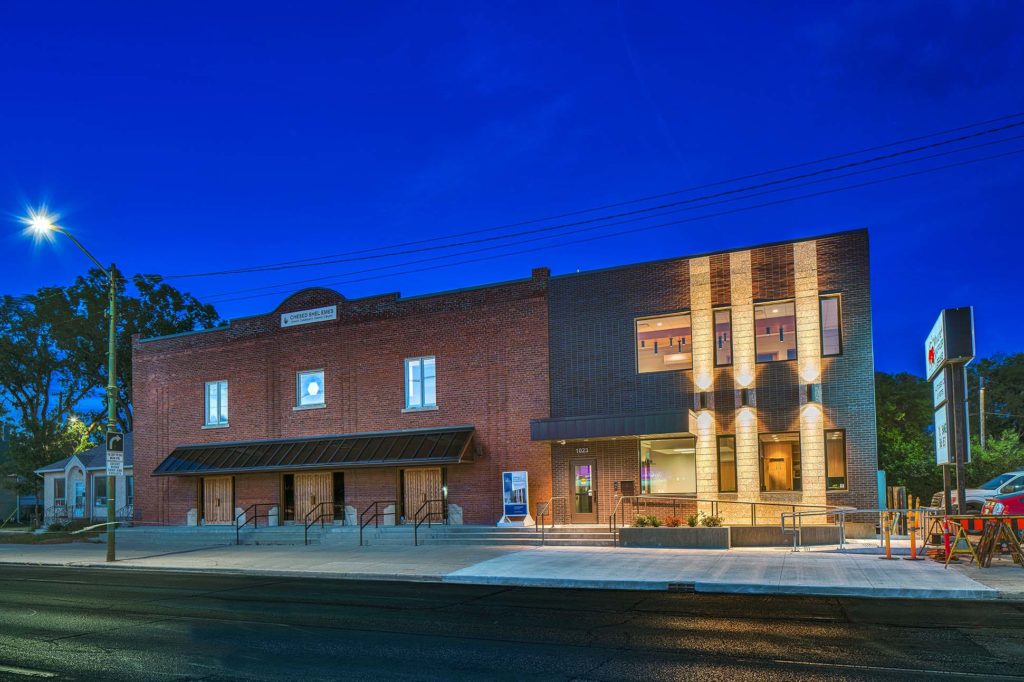
We’re delighted to share a major milestone in our Capital Campaign, “Building on our Tradition.” Launched in November 2018, this campaign aimed to replace our outdated facility with a modern space tailored to our unique needs. Our new building is designed with ritual at its core, featuring ample preparation space, Shomer space, and storage, creating a warm and welcoming environment for our community during times of need.
We’re grateful to the nearly 1,000 generous donors who contributed over $4 million towards our new facility. A $750,000 mortgage will be retired in November 2025, completing this monumental project in just seven years.
We’re also thrilled to announce that our Chesed Shel Emes Endowment Fund has grown tenfold, from $15,000 to $150,000, thanks to you, the Jewish Foundation of Manitoba’s FundMatch program, and Million Dollar Match initiative in 2024. Our fund helps ensure that everyone can have a dignified Jewish funeral regardless of financial need.
As we look to the future, our goal remains to ensure the Chevra Kadisha continues to serve our community for generations to come. Our focus now shifts to replenishing our savings account and growing our JFM Endowment fund.
We’re deeply grateful for your support over the past several years.
It’s our privilege to serve our community with care and compassion.
With sincere appreciation,
Campaign cabinet: Hillel Kravetsky, Gerry Pritchard, Stuart Pudavick,
Jack Solomon, and Rena Boroditsky
Murray S. Greenfield, President
Local News
Winnipeg Beach Synagogue about to celebrate 75th anniversary
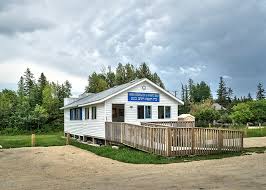
By BERNIE BELLAN (July 13) In 1950 a group of cottage owners at Winnipeg Beach took it upon themselves to relocate a one-room schoolhouse that was in the Beausejour area to Winnipeg Beach where it became the beach synagogue at the corner of Hazel and Grove.
There it stayed until 1998 when it was moved to its current location at Camp Massad.
On August 2nd members of the synagogue will be holding a 75th anniversary celebration.
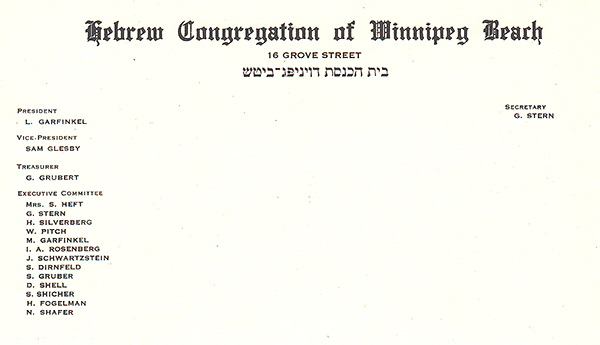
As part of the celebration anyone who is a descendant or relative of any of the original members of the first executive committee (as seen in the photo here) is invited to attend the synagogue that morning.
If you are a relative please contact Abe Borzykowski at wpgbeachshule@shaw.ca or aborzykowski@shaw.ca to let Abe know you might be attending or for more information about the 75th anniversary celebration.
We will soon be publishing a story about the history of the beach synagogue, which is something I’ve been writing about for over 25 years.
Local News
Vickar Family cuts ribbon on new Tova Vickar and Family Childcare Centre
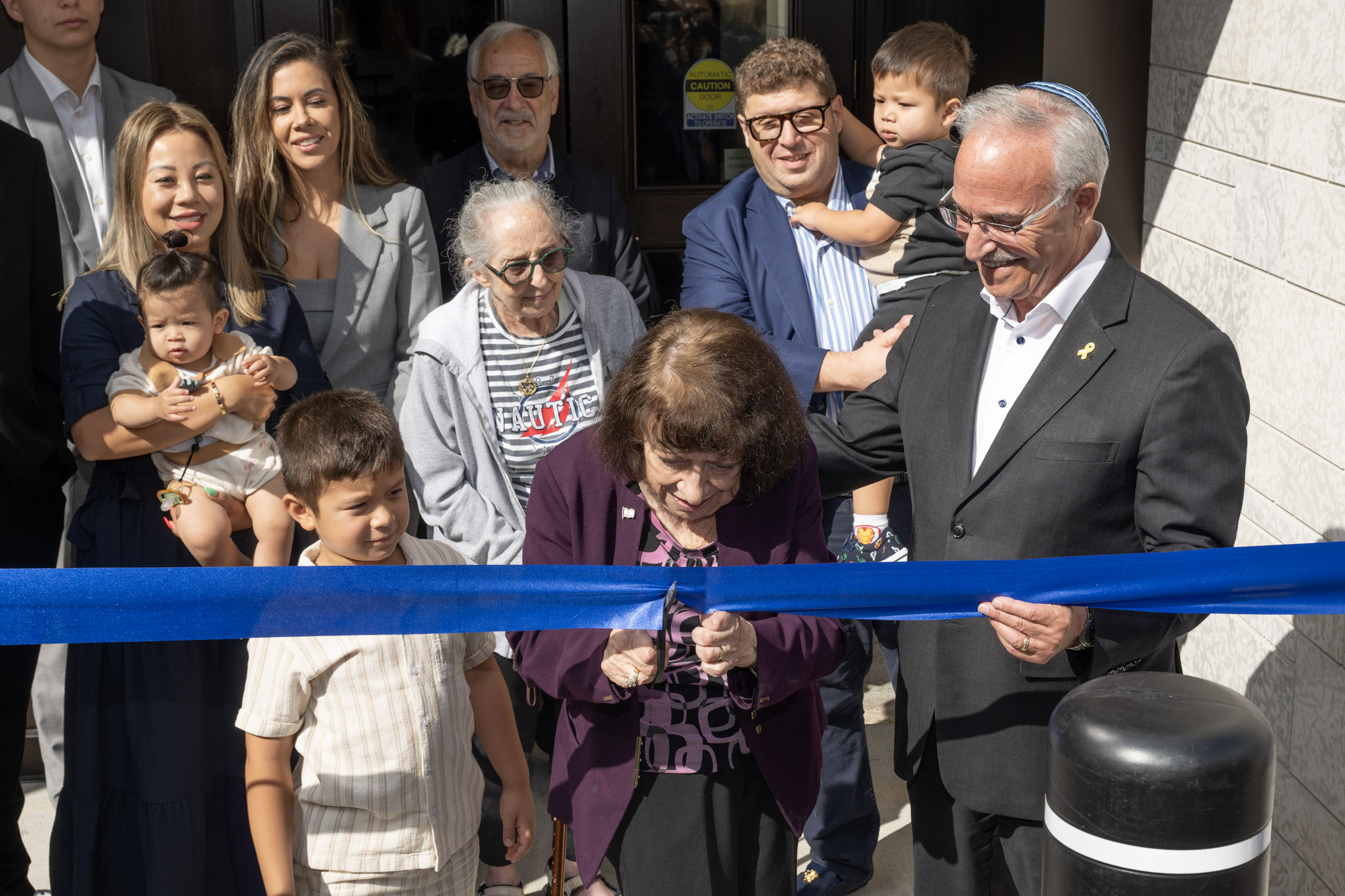
By MYRON LOVE In the words of Larry Vickar, the Shaarey Zedek’s successful Dor V’ Dor Campaign “is not only a renewal of the synagogue but truly a renewal movement of Jewish life in our community.”An integral part of that renewal movement was the creation of a daycare centre within the expanded synagogue. On Monday, June 23, Larry and Tova Vickar cut the ribbon, thereby officially opening the Tova Vickar and Family Childcare Centre in the presence of 100 of their family members, friends and other supporters of the project.
The short program preceding the morning ribbon-cutting began with a continental breakfast followed by a welcome by both Fanny Levy, Shaarey Zedek’s Board President, and Executive Director Dr. Rena Secter Elbaze. In Elbaze’s remarks, she noted that Larry and Tova wanted their family (including son Stephen and family, who flew in from Florida) and friends at the event to celebrate the opening of the Tova Vickar and Family Childcare Centre, “not because of the accolades, but because, as Larry put it, he hopes that their investment in the congregation will inspire others to do the same.”
“When Larry and I spoke about what this gift meant to him and the message he wanted people to take away,” she continued, “I couldn’t help but connect it to the teachings of Reb Zalman Schachter-Shalomi whose book – Age-ing to Sage-ing – changes the whole way we look at the concept of ageing and basing it on our ancestral teachings.”
She explained that his concept of “Sage-ing” is based on three key ideas – Discover your meaning and purpose; accept our mortality and think about the legacy you want to leave.
“Larry spoke about these exact concepts when we met,” she said.
Elbaze also noted the presence of Shaarey Zedek’s newly-arrived senior Rabbi Carnie Rose, former Rabbi Alan Green, and area MLAs Mike Moroz and Carla Compton.
Larry Vickar expressed his great appreciation for all those in attendance. “Tova and I are deeply moved to stand here with you today for this important milestone in our community”, he said. “We are grateful to be surrounded by all of you, the people we care about, our family and friends… you who have touched our lives and played some part in our journey.”
